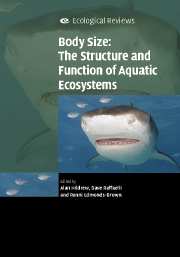Book contents
- Frontmatter
- Contents
- List of contributors
- Preface
- 1 The metabolic theory of ecology and the role of body size in marine and freshwater ecosystems
- 2 Body size and suspension feeding
- 3 Life histories and body size
- 4 Relationship between biomass turnover and body size for stream communities
- 5 Body size in streams: macroinvertebrate community size composition along natural and human-induced environmental gradients
- 6 Body size and predatory interactions in freshwaters: scaling from individuals to communities
- 7 Body size and trophic cascades in lakes
- 8 Body size and scale invariance: multifractals in invertebrate communities
- 9 Body size and biogeography
- 10 By wind, wings or water: body size, dispersal and range size in aquatic invertebrates
- 11 Body size and diversity in marine systems
- 12 Interplay between individual growth and population feedbacks shapes body-size distributions
- 13 The consequences of body size in model microbial ecosystems
- 14 Body size, exploitation and conservation of marine organisms
- 15 How body size mediates the role of animals in nutrient cycling in aquatic ecosystems
- 16 Body sizes in food chains of animal predators and parasites
- 17 Body size in aquatic ecology: important, but not the whole story
- Index
- References
14 - Body size, exploitation and conservation of marine organisms
Published online by Cambridge University Press: 02 December 2009
- Frontmatter
- Contents
- List of contributors
- Preface
- 1 The metabolic theory of ecology and the role of body size in marine and freshwater ecosystems
- 2 Body size and suspension feeding
- 3 Life histories and body size
- 4 Relationship between biomass turnover and body size for stream communities
- 5 Body size in streams: macroinvertebrate community size composition along natural and human-induced environmental gradients
- 6 Body size and predatory interactions in freshwaters: scaling from individuals to communities
- 7 Body size and trophic cascades in lakes
- 8 Body size and scale invariance: multifractals in invertebrate communities
- 9 Body size and biogeography
- 10 By wind, wings or water: body size, dispersal and range size in aquatic invertebrates
- 11 Body size and diversity in marine systems
- 12 Interplay between individual growth and population feedbacks shapes body-size distributions
- 13 The consequences of body size in model microbial ecosystems
- 14 Body size, exploitation and conservation of marine organisms
- 15 How body size mediates the role of animals in nutrient cycling in aquatic ecosystems
- 16 Body sizes in food chains of animal predators and parasites
- 17 Body size in aquatic ecology: important, but not the whole story
- Index
- References
Summary
Introduction
Aquatic ecologists and conservationists have long been obsessed with trying to understand links between body size, exploitation and conservation (e.g. Adams, 1980; Dickie, Kerr & Schwinghamer, 1987a). There are several reasons for this interest. First, at the individual level, fisheries management for both vertebrate and invertebrate populations tries to minimize the mortality of smaller individuals, in order to increase the probability that individuals have reproduced before they are caught (Jennings, Kaiser & Reynolds, 2001a). Even if other management methods are used, practically every stock assessment that has ever been done on an indeterminately growing species has included size as a key input parameter. Second, at the population level, large-bodied species have life-history traits that lead to slow rates of population turnover, with clear implications for productivity, resilience and recovery potential (Hutchings, 2001; Denney, Jennings & Reynolds, 2002; Reynolds et al., 2005; Goodwin et al., 2006). Third, at the community level, predator–prey relationships are strongly linked to size (Cohen et al., 1993; Woodward & Warren, this volume; Persson & De Roos, this volume), leading to the potential for understanding how fishing mortality may have wider ecosystem impacts through food-web dynamics (Dickie et al., 1987a).
At the population level, studies of the effects of exploitation have long focused on the direct effects of fishing mortality on a single stock, and this is often a pragmatic response to limited information on the indirect effects of mortality on one species affecting other species in the ecosystem (Hilborn & Walters, 1992).
- Type
- Chapter
- Information
- Body Size: The Structure and Function of Aquatic Ecosystems , pp. 266 - 285Publisher: Cambridge University PressPrint publication year: 2007
References
- 5
- Cited by

